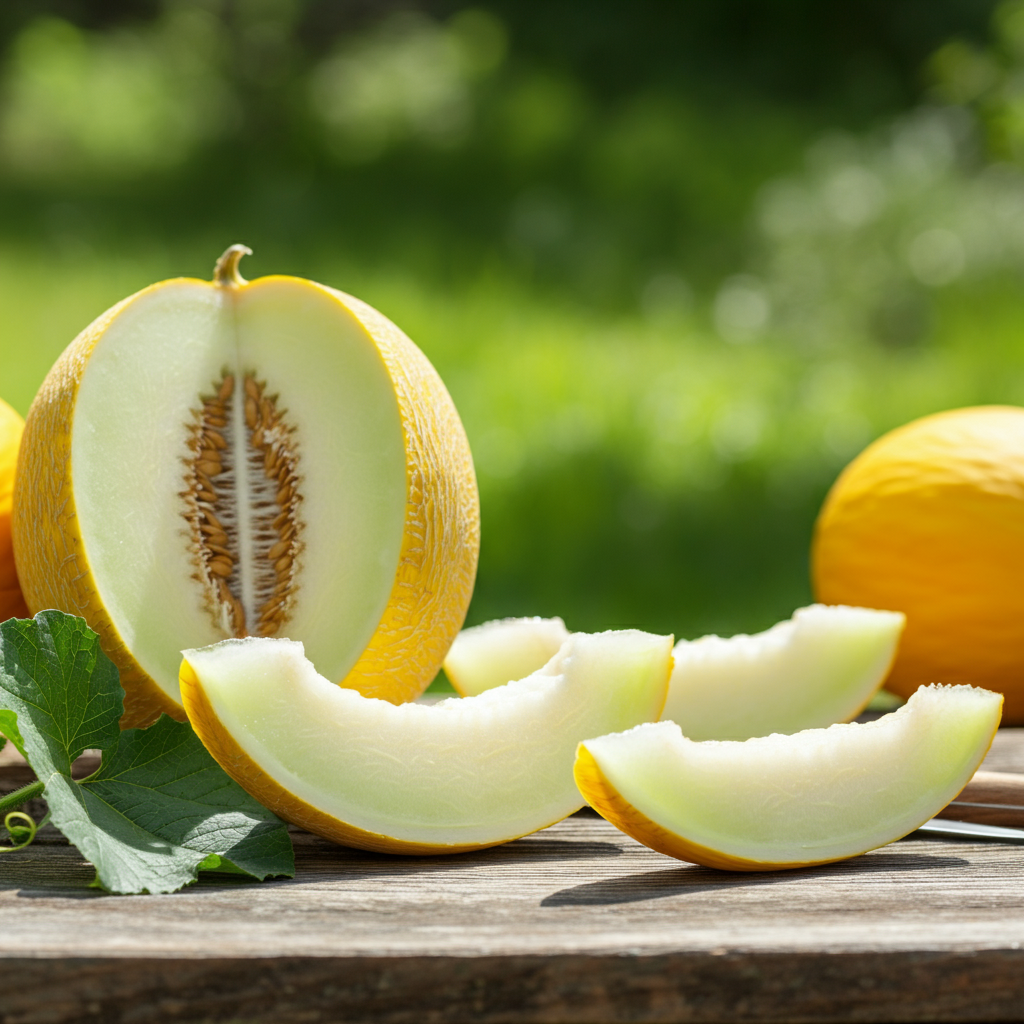Sweet, vibrant, and bursting with nutritional goodness, the canary melon is a fruit that deserves a spot in your kitchen, whether you’re a fruit aficionado or seeking a healthy yet delicious snack. The canary melon checks all the boxes.
But what exactly is this bright yellow fruit, and why is it gaining popularity among fruit lovers and nutritionists alike? Stick around, and by the end of this guide, you’ll know everything about canary melons—from their flavor profile to growing them in your garden.
Table of Contents
What Is a Canary Melon?
The canary melon, scientifically classified as Cucumis melo var. Inodorus, is a type of muskmelon. Known for its striking, bright yellow rind, the canary melon is oval-shaped with a waxy texture on the outside. Inside, the pale green to-white flesh offers a juicy and refreshing bite.
Sometimes referred to as a “winter melon” because of its extended shelf life, this fruit is popular worldwide and is enjoyed as a fresh treat or incorporated into various dishes.
The Flavor Profile of Canary Melons
The taste of a canary melon is as enticing as its bright exterior. Often described as a cross between a honeydew melon and a pear, it offers a natural sweetness with a slight tangy undertone. The texture is soft yet firm, providing a satisfying bite without being overly delicate.
Some also liken the taste to what you’d get from combining a cantaloupe with a honeydew, giving it a unique flavor that’s mellow yet distinctive.
Nutritional Benefits of Canary Melons
A Healthy Indulgence
Canary melons aren’t just delicious; they pack a punch in the nutrition department. Here’s what makes them a standout choice for health-conscious individuals:
- Rich in Vitamins: A great source of vitamin A and vitamin C, canary melons support healthy skin, vision, and immune function.
- Low in Calories: With a low-calorie count, they’re perfect for those looking to enjoy a guilt-free treat.
- High in Dietary Fiber: Canary melons aid digestion and maintain a healthy gut.
- Fat-Free and Vegan-Friendly: They are naturally fat-free and align perfectly with vegan and plant-based diets.
Whether eaten solo or paired with other fruits, they’re a great addition to a balanced diet.
Culinary Uses
One of the best things about canary melons is their culinary versatility. Here are some of the most popular ways to enjoy them:
Eating Fresh
The simplest way to enjoy a canary melon is by slicing and eating it fresh. Its naturally sweet flavor makes it a wonderfully refreshing snack on a hot day.
Adding to Salads and Fruit Bowls
Combine diced canary melon with other seasonal fruits to create a colorful and nutritious fruit salad. Or mix it with greens, feta cheese, and a light vinaigrette for a savory twist.
Blending into Smoothies
For a creamy, refreshing smoothie, blend canary melon with a splash of coconut water and a handful of mint leaves.
The possibilities are endless when it comes to incorporating this delicious fruit into your meals!
Growing Canary Melons
Ideal Growing Conditions
Canary melons thrive in warm climates with plenty of sunlight. They grow best in well-draining soil rich in organic matter. Ensuring your melon plants are watered consistently will also lead to a healthier crop.
Harvesting Tips
A ripe canary melon is easy to spot thanks to its vibrant yellow rind. When ready for harvest, it will feel slightly firm to the touch but emit a subtle, fruity aroma.
Other Names and Varieties
Depending on where you’re located, you might come across canary melons by different names. Common alternatives include “Juan Canary Melon,” “Spanish Melon,” “Jaune des Canaries,” and “Amarillo Melon.”
Despite their many monikers, the taste and characteristics remain consistent across these varieties.
FAQs About Canary Melons
What does a canary melon taste like?
Canary melons have a sweet, delicate flavor often compared to honeydew or a mix of honeydew and pear, with a subtle tangy finish.
How do I know if a canary melon is ripe?
A ripe canary melon will have bright yellow skin with no green patches. It should feel firm but give slightly when gently pressed.
How should I store a canary melon?
Store whole canary melons at room temperature until ripe. Once cut, wrap the melon tightly and refrigerate for up to 5 days.
Is canary melon good for weight loss?
Yes! Canary melons are low in calories and fat, making them a great option for anyone on a weight-loss or low-calorie diet.
Reap the Benefits of Canary Melons
The canary melon is more than just a visually appealing fruit. It’s a nutrient-rich, versatile, and delicious addition to any home kitchen. Whether you’re savoring it fresh, adding it to creative dishes, or growing your own, this fruit brings both beauty and benefits to the table.
Please take advantage of the unique flavor and health perks of the canary melon during its peak season and elevate your fruit game today!

